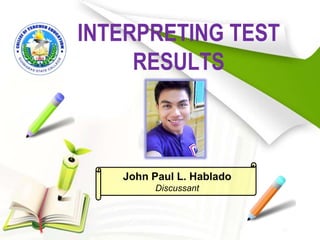
Interpreting test results
- 1. INTERPRETING TEST RESULTS John Paul L. Hablado Discussant
- 2. Outline 1. Two Methods of Interpreting Test Scores 2. Standard Score Norms 3. Areas under the Normal Curve 4. Guidelines in Interpreting Test Results 2Facilitator: John Paul L. Hablado
- 3. Two Methods of Interpreting Test Scores 3 Norm- referenced (based on norm) Criterion- referenced Facilitator: John Paul L. Hablado
- 4. Standard Score Norms 4 T-Scores Z-Scores Standard Score Norms Indicates student’s relative position by showing how far his raw score is above or below average Facilitator: John Paul L. Hablado
- 5. PROBLEM John scored 145 on an IQ test with a mean of 100 and a standard deviation of 15. What is his z-score ?T-score? 5 Let us solve this problem. Can you help me? Facilitator: John Paul L. Hablado
- 6. Facilitator: John Paul L. Hablado 6 SOLUTION It is easy, isn’t it?Let’s do it!
- 7. Interpretation 7 John’s z-score is +3. Z –scores measure the distance of a score from the mean in units of standard deviation. Since the mean is 100 and the standard deviation is 15, John’s score is 3 standard deviations above the mean. T –score = 50+ 10 z = 50+10 (3) = 80 Since T-scores always have a mean of 50 and a standard deviation of 10. A T-score 80 indicates 3 sd above the mean. Facilitator: John Paul L. Hablado
- 8. PROBLEM Study this group of tests which was administered with the following results, then answer the questions. Facilitator: John Paul L. Hablado 8
- 9. Facilitator: John Paul L. Hablado 9 USE THESE FORMULAS.
- 10. Facilitator: John Paul L. Hablado 10 QUESTIONS
- 11. Properties of the Normal Distribution 1. It is bell-shaped. 2. The mean, median and mode are equal and located at the center of the distribution. 3. It is unimodal. 4. It is symmetrical about the mean. 5. It is continuous. 6. The curve never touches the x-axis. 7. The total area under the normal distribution curve is equal to 1 or 100%.Facilitator: John Paul L. Hablado 11 AREAS UNDER THE NORMAL CURVE
- 12. Facilitator: John Paul L. Hablado 12 EXAMPLES
- 13. Facilitator: John Paul L. Hablado 13
- 14. GUIDELINES IN INTERPRETING TEST RESULTS 1. Test results should be interpreted in terms of the test items from which they were obtained. 2. It should be interpreted in relation to other information about the background or characteristics of the students. 14Facilitator: John Paul L. Hablado
- 15. GUIDELINES IN INTERPRETING TEST RESULTS 3. It should be interpreted in terms of our purposes or the decision we are about to make. 4. Test results are not exact measures; allowance for errors should be made. 15Facilitator: John Paul L. Hablado
- 16. GUIDELINES IN INTERPRETING TEST RESULTS 5. Test results should be supported by other evidence or information. 16 Ponder these guidelines! Facilitator: John Paul L. Hablado
- 17. TO BE CONTINUED… “ Think big. Think fast. Ideas are no one’s monopoly.” Thank you for listening, and God bless everyone! 17Facilitator: John Paul L. Hablado
